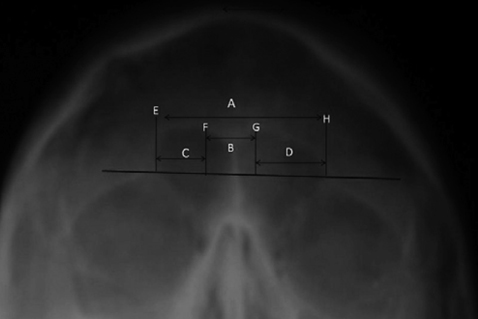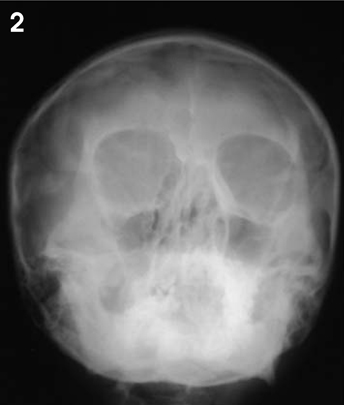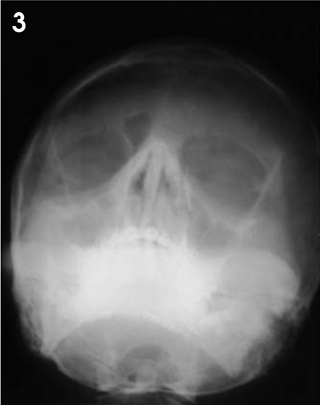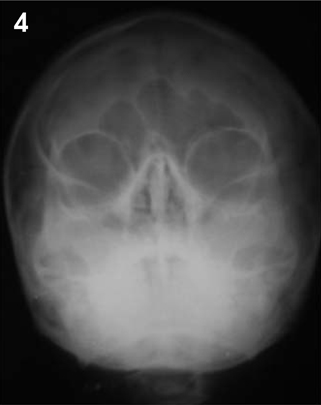Imaging Sci Dent.
2012 Dec;42(4):213-217. 10.5624/isd.2012.42.4.213.
Uniqueness of radiographic patterns of the frontal sinus for personal identification
- Affiliations
-
- 1Department of Oral Medicine and Radiology, MGM, Dental College and Hospital, Navi Mumbai, India. drnehaapatil@gmail.com
- 2Department of Oral Medicine and Radiology, Nair Hospital Dental College, Mumbai, India.
- KMID: 1806786
- DOI: http://doi.org/10.5624/isd.2012.42.4.213
Abstract
- PURPOSE
This study was performed to evaluate the uniqueness and reliability of the frontal sinuses by comparing various patterns of frontal sinus as observed on Waters' radiographs for individual identification.
MATERIALS AND METHODS
Three Waters' radiographs of 100 individuals, taken on day one, after 6-8 months, and one radiograph with a slight variation in angulation, to mimic conditions out in the field or during autopsy. Three observers were randomly given radiographs from all there packets for comparisons and identification, by the method of superimposition and individual uniqueness.
RESULTS
The comparative identification by superimposition of the frontal sinus was 100% positive. The size, shape, unilateral or bilateral presence, absence, and septa were observed to be unique in each case; neither had the measurements changed over a period of time.
CONCLUSION
The need to establish a reliable, low-cost, and easily reproducible method for human identification prompted the elaboration of technical, precise, and accessible parameters, such as the evaluation of the area, asymmetry, and shape of the frontal sinus. Comparison among each of the frontal sinuses of the 100 people in the sample revealed that no two sinuses are the same, that is, the sinus is unique to each individual.
Keyword
Figure
Cited by 1 articles
-
Distribution of frontal sinus pattern amongst Malaysian population: a skull radiograph study
Nur Damia Iwani Zulkiflee, Mansharan Kaur Chainchel Singh, Aspalilah Alias, Helmi Mohd Hadi Pritam, Eric Chung, Rani Sakaran, Nurul Hannim Zaidun, Choy Ker Woon
Anat Cell Biol. 2022;55(3):294-303. doi: 10.5115/acb.22.075.
Reference
-
1. Kanchan T, Krishan K, Menezes RG, Suresh Kumar Shetty B, Lobo SW. Frontal sinus radiographs-a useful means of identification. J Forensic Leg Med. 2010. 17:223–224.2. Igbigbi PS, Nanono-Igbigbi AM. Determination of sex and race from the subpubic angle in Ugandan subjects. Am J Forensic Med Pathol. 2003. 24:168–172.
Article3. Schuller A. Note on the identification of skulls by X-ray pictures of the frontal sinuses. Med J Aust. 1943. 1:554–556.4. Yoshino M, Miyasaka S, Sato H, Seta S. Classification system of frontal sinus patterns by radiography. Its application to identification of unknown skeletal remains. Forensic Sci Int. 1987. 34:289–299.
Article5. Tang JP, Hu DY, Jiang FH, Yu XJ. Assessing forensic applications of the frontal sinus in a Chinese Han population. Forensic Sci Int. 2009. 183:104.e1–104.e3.
Article6. Ribeiro Fde A. Standardized measurements of radiographic films of the frontal sinuses: an aid to identifying unknown persons. Ear Nose Throat J. 2000. 79:26–33.
Article7. Kullman L, Eklund B, Grundin R. Value of the frontal sinus in identification of unknown persons. J Forensic Odontostomatol. 1990. 8:3–10.8. Quatrehomme G, Fronty P, Sapanet M, Grévin G, Bailet P, Ollier A. Identification by frontal sinus pattern in forensic anthropology. Forensic Sci Int. 1996. 83:147–153.
Article9. Cox M, Malcolm M, Fairgrieve SI. A new digital method for the objective comparison of frontal sinuses for identification. J Forensic Sci. 2009. 54:761–772.
Article10. Christensen AM. Assessing the variation in individual frontal sinus outlines. Am J Phys Anthropol. 2005. 127:291–295.
Article11. Marlin DC, Clark MA, Standish SM. Identification of human remains by comparison of frontal sinus radiographs: a series of four cases. J Forensic Sci. 1991. 36:1765–1772.
Article12. Nambiar P, Naidu MD, Subramaniam K. Anatomical variability of the frontal sinuses and their application in forensic identification. Clin Anat. 1999. 12:16–19.
Article13. Nahum AM. The biomechanics of maxillofacial trauma. Clin Plast Surg. 1975. 2:59–64.
Article14. Wallis A, Donald PJ. Frontal sinus fractures: a review of 72 cases. Laryngoscope. 1988. 98:593–598.15. Tatlisumak E, Ovali GY, Asirdizer M, Aslan A, Ozyurt B, Bayindir P, et al. CT study on morphometry of frontal sinus. Clin Anat. 2008. 21:287–293.
Article






